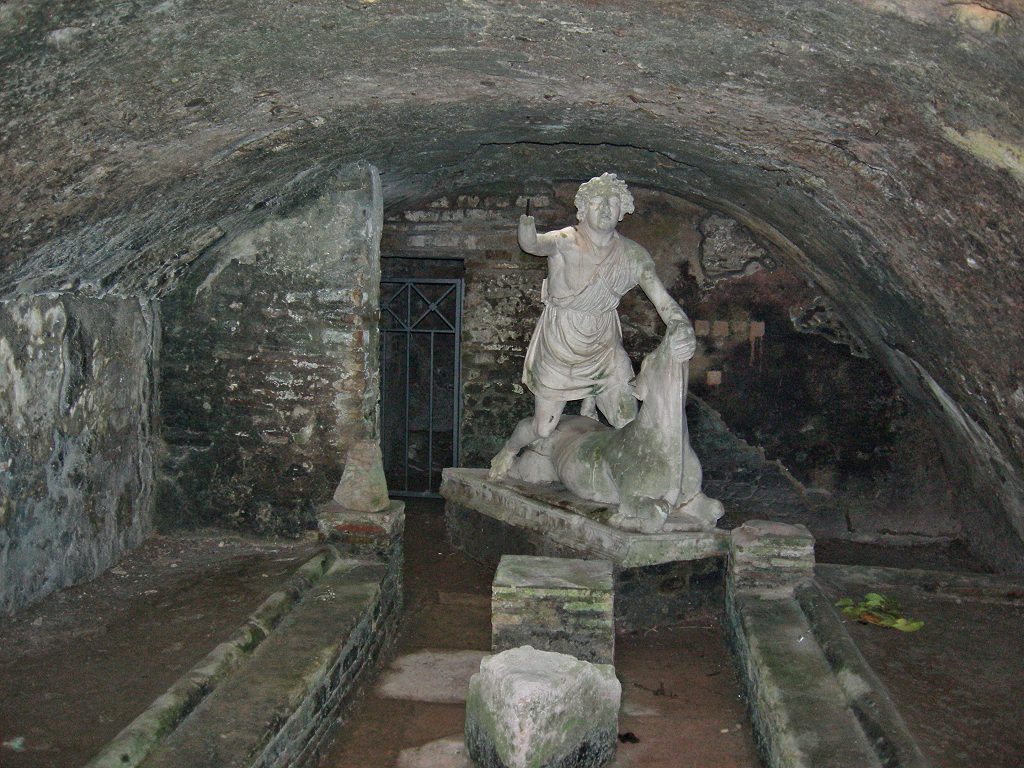|
The mithraeum was installed in the service area of the Baths of Mithras. Some walls of opus vittatum were added. The shrine was reached via a brick staircase. The entrance is between two cross-walls. The inside measurements are 15.37 x 4.55, the maximum height of the vault is 2.10. A back wall was added with a door in the east side (w. 0.80, h. 1.65), leading to the service area. A small cross-wall made the door invisible. In the vault are two square skylights, one in the centre, one in the south part, above the head of Mithras about to kill the bull (see below). From the skylights can be deduced that the ceremonies in the shrine took place during the day. We may also assume that the baths were then not yet open, which takes us to the early morning, perhaps daybreak. In the east side of the vault, near the entrance, is a square shallow recess (0.60 x 0.60), painted red, presumably for a relief or inscription. There are a few remains of paintings, of landscapes and standing figures. The podia are low (0.33), and divided into two sections by a pre-existing reinforcing arch of opus latericium. At the south end of the podia are two small brick piers (h. 0.55), on top of which two small, truncated pyramids of tufa with a rough surface were found (0.20 x 0.20, h. 0.30). They refer to the rock from which Mithras was born (saxigenus). In the vertical side of the podia, halfway down the shrine, are niches. They probably contained two small altars of tufa, also rough truncated pyramids, with a hole in the top, found in the shrine (0.13 x 0.13, h. 0.20). The shrine has a brick floor. On the floor, between the south ends of the podia, is a square brick base (0.42 x 0.42, preserved h. 0.50). In front is a small, plastered, triangular altar of masonry. On the three corners stood small, triangular pilasters of masonry, originally supporting something. Behind the podia a statue of Mithras about to kill the bull was found in situ, resting on a masonry base placed diagonally (h. 0.30). The head of the god was illuminated in a dramatic way through a skylight. The height of the statue is 1.70. It is made of Greek marble. The blade of the knife is missing. It was probably made of metal. The Phrygian cap was made separately and is also missing, as are the metal rays that were fastened in holes. The head of the bull and the head and an arm of Mithras were found in a channel in the mithraeum, together with small fragments of the statue, that are ancient restorations. The statue stands upon a base of grey marble (resting on the masonry base), the same kind of marble used for the restorations. Obviously a damaged statue had been acquired. The fragments must have been thrown in the channel by Christians, who erected a small edifice above the mithraeum. On the chest of the bull is the inscription:
The artist may have been Marcus Umbilius Criton, who is documented in the Mitreo della Planta Pedis (III,XVII,2). The statue seems to belong to the second century AD. The mithraeum may have been installed in the first half of the third century. |
 Plan of the mithraeum. From SO II, fig. 7. |


